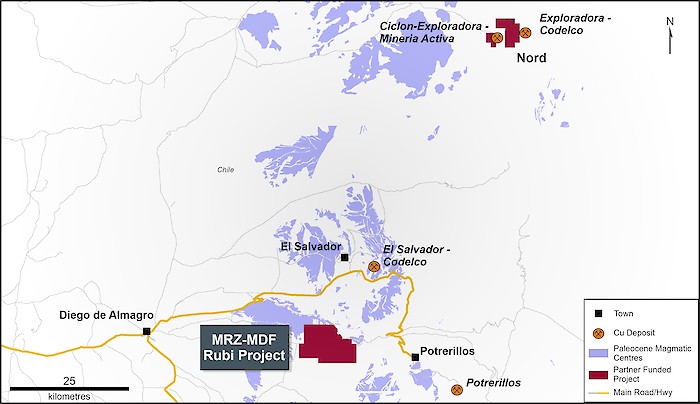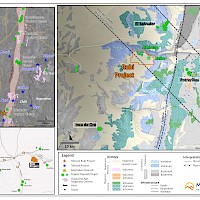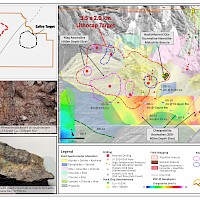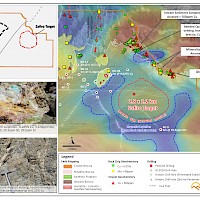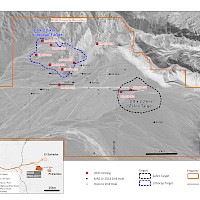Rubi
-
Property Type
Porphyry Copper Project
Size
7,543 ha
Status
Available for Partnership
Exploration Stage
1,887m drill program completed under agreement with MDF
Initial drilling, geological mapping, geochemical sampling, geophysical surveysLocation
- Paleocene age porphyry belt of northern Chile
- Lies at relatively low elevation within 20 km of El Salvador and Portrerillos porphyry Cu-Mo-Au mines
- Year-round access
- Adjacent townships with a trained mining workforce, nearby roads, power, water grid and an operating mill and smelter
The 7,543 ha Rubi project is located within the prolific Paleocene age porphyry belt of northern Chile, which is host to a number of significant, currently producing porphyry Cu deposits. The project lies at relatively low elevation (1,900-2,100m), within 20 km of both the El Salvador Cu-Mo-Au mine and the Potrerillos smelter, with excellent access to port facilities at Chanaral located some 80 km to the west.
In a regional context, the project has a prospective geological setting being centered on the structural intersections of the Domeyko fault system and the Ojos del Salado trans-orogen structural corridor, which is interpreted to have influenced the emplacement of the nearby El Salvador and Potrerillos deposits.
Under the option agreement with MDF, Mirasol completed a 1,887m drill program in 2021 at the Rubi project testing the Lithocap and Zafiro Cu-Mo-Au porphyry-style targets. The results from this program supports the presence of a large and strong prospective porphyry-style alteration system. Key indicators included the occurrence of porphyritic daci-andesite intrusive rocks and hydrothermal brecciation, which exhibit strong quartz-sericite (phyllic) alteration overprinting a relict K-feldspar alteration that host trace fine pyrite-chalcopyrite-magnetite mineralization. In addition, good ground preparation was observed, which is critical for mineral deposition, with strong to locally intense fracturing infilled with late gypsum/anhydrite and calcite veining. Importantly, assay results confirmed the presence of anomalous Cu, Mo and locally elevated As over substantial intervals of approx. 200m.
MDF has confirmed their continued commitment to the project and a deep-sensing IP and magnetotellurics geophysical program is expected to be completed to better delineate the porphyry Cu target for follow up drilling.
Target Overview:
Zafiro Target
The target at Zafiro is a blind porphyry Cu system defined by a magnetic high anomaly ringed by a magnetic low, which is considered to represent a phyllic halo around a potential central altered potassic mineralized porphyry. Only two holes RB-DD-001 and RB-DD-009, drilled some 660m apart, have been completed into this large 2.8km by 2.2km target. Both holes appear to have successfully intersected, below a thick (325-382m) sequence of cover Atacama gravels, the strong to locally intense phyllic altered halo of porphyry-breccia system.
This drilling at Zafiro intersected a sequence of andesitic volcanic rocks intruded by a quartz monzonitic diorite intrusive body, which has itself been intruded by younger dykes or small stocks of dacite to andesite porphyry. Phyllic alteration (peripheral and cooler temperature) in the dacite to andesite porphyry intrusive rocks carry 1-3% pyrite hosted as veinlets and as disseminations, and appear to overprint a potassium (proximal and higher temperature) feldspar alteration event. Petrological (microscope) studies show fine chlorite-carbonate pyrite-chalcopyrite in veinlets hosted in the altered andesite porphyry. Notably, hydrothermal breccias with high temperature magnetite-K feldspar-albite alteration were intercepted, which locally host chalcopyrite-pyrite-specular hematite veining. Both the younger porphyry stocks and the breccia units are prospective hosts for economic mineralization.
Assay results for both holes (RD-DD-001/009) returned weakly anomalous Cu (~105 ppm) over significant intercepts (~200m), including a higher-grade 4m interval in hole RB-DD-001 from a phyllic altered zone, which averaged 416 ppm Cu, and elevated As and Mo (640-1040 ppm and 7-11 ppm, respectively). The daci-andesite porphyry in RB-DD-009 returned over a 47.6m interval 126 ppm Cu, 27 ppm Mo, 23 ppm Pb and 230 ppm Zn. These anomalous levels of Cu and associated metals are not uncommon in peripheral porphyry environments. In addition, an epithermal signature (Hg, Sb, As, Bi, Te) is present in the upper parts of RB-DD-009, and may represent an upper to mid-level of this partially eroded porphyry system.
Lithocap Target
At the Lithocap target, seven short vertical holes (for 569m) were completed to sample bedrock under shallow gravel cover to the west and south of the outcropping lithocap. The hydrothermal brecciation and phyllic alteration intersected by these drill holes is the strongest encountered on the target to date and indicates that the drilling is potentially closing in on the central more prospective part of this porphyry system. Vectoring from the data provided from these drill holes combined with that from previous drill holes at Rubi, led to a single vertical, deeper hole RB-DD-010 also being drilled.
Hole RB-DD-010 returned the most interesting results to date at Lithocap, intersecting strongly clay weathered and crackle brecciated andesite with 2-5% jarosite with strong associated goethite/hematite, beneath 90m of loosely consolidated gravel cover. Below the oxidation level (132m), 4-10% pyrite occurs as disseminations and veinlets in hydrothermal breccias and their crackle brecciated margins. These hydrothermal breccias were observed interfingering with weakly altered andesite over the entire 155.7m of intersected bedrock, perhaps suggesting that that RB-DD-010 intersected the margins of a breccia system.
Late gypsum/anhydrite veining is intensely developed and forms up to 30% of the volume in bedrock. Similar late gypsum/anhydrite veining was encountered in previous drilling to the north (RUBRD14_016, RUBRD14_001, RUBRD14_015). In both targets, these strongly fractured rocks with the latter gypsum/anhydrite infill could indicate the hydraulically fractured outer shell (carapace) of a concealed porphyry system.
Assays from hole RB-DD-010 returned anomalous Cu and Mo over the entire extent of bedrock intercepted (155.7m from 89.9 to 245.6m), with weighted averages of 124 ppm Cu and 2.2 ppm Mo (ranging from 25 – 334 ppm and from 0.4 – 12ppm respectively).
Previous Exploration Work
Between 2007 and 2012, Mirasol has completed reconnaissance exploration including stream and rock geochemical sampling, regional mapping and PIMA analysis of the prospect area. The exploration work enabled Mirasol to identify the initial Lithocap prospect.
Under a partnership with Mirasol, First Quantum Minerals (FQM) completed multiple exploration programs between 2013 and 2015 to further explore Rubi project. The programs include a 2,460 line-km, detailed, low-altitude, helicopter-borne magnetic (helimag) survey covering the entire Rubi project, property-wide geological mapping and rock chip sampling, and orientation soil sampling was also completed at the Lithocap prospect. A 6,054 m, 16-hole combined reverse-circulation and diamond drill program predominantly focused in the Lithocap area was also completed in 2015.
In 2017, Mirasol consolidated its claims holdings at Rubi and completed field evaluation and targeting programs that refined three large-scale Cu-Mo-Au targets at the Lithocap and Zafiro prospects. The targets were defined by integrated analysis, including re-logging of drill holes and the re-interpretation of geophysics and geochemistry from previous partner exploration work at Rubi.
-
-
Rubi Commenced 2,000m Drill Program
